|

Winter 2000 (8.4)
Pages
38-39
Making Houses into Homes
Eni and
UNHCR Team up to Help Refugees
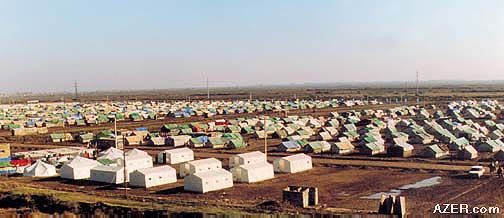
Above: Refugee tent camps in
Sabirabad supplied by the Norwegian Red Cross and funded by the
Norwegian government. The tents, intended as temporary shelter,
have long since worn out and replaced by mud-brick shelters that
were built by the refugees themselves. Photo: IFRCRC, December
1994.
Azerbaijan
has approximately 1 million refugees as a result of the Nagorno-Karabakh
war with Armenia. Many of them fled their homes with just a few
moments' notice, grabbing the hands of their children and running
out the door with nothing but the clothes on their backs. In
towns like Kalbajar, 3,000 meters up in the Caucasus mountains,
they trekked through mountain passes in the snow for several
days seeking refuge. Some died from over-exposure to the cold;
others still suffer from consequences of frostbite.
Azerbaijan's refugees still dream of returning home despite the
fact that it's been nearly nine years now that some of them have
been living in temporary quarters - tent camps, abandoned buildings,
railroad boxcars and underground dugouts. Azerbaijan's governmental
officials insist that one of the conditions of peace with Armenia
must be that these refugees can return to their homelands.
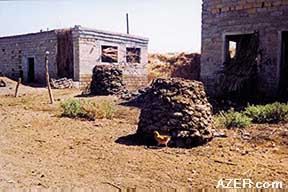  Left: Many refugees moving to the new camp
at Beylagan had been living in buildings originally intended
for sheep and cattle. Note the piles of sheep manure carefully
gathered to be used as cooking fuel. International. Left: Many refugees moving to the new camp
at Beylagan had been living in buildings originally intended
for sheep and cattle. Note the piles of sheep manure carefully
gathered to be used as cooking fuel. International.
In the meantime, Eni, through its subsidiary Agip Azerbaijan,
is funding a $2.25 million project to help provide two new settlements
for Azerbaijan's refugees - for approximately 400 families in
the towns of Khanlar and Beylagan. UNHCR is administrating the
project under the direction of Didier Laye.
_____
Finally, moving day had arrived. Refugee families packed up their
meager possessions - blankets, clothes, stuffed mattresses, a
few pots, plates and utensils - and headed to Beylagan, a new
settlement in central Azerbaijan. After seven years as refugees,
they still didn't have much in the way of material goods, but
many families carried with them small pots of plants - flowers
and herbs like mint and basil. Some they would put in their windows.
Some they would plant outside.
"It's quite natural," says Vugar Abdusalimov,
Public Information Officer for UNHCR, which organized the shelters'
construction. "Even in the worst conditions, you see refugees
trying to plant herbs and flowers - trying to create a touch
of color. People want to ornament their lives despite the misery
they live in. It seems innate - this quest for beauty and aesthetics."
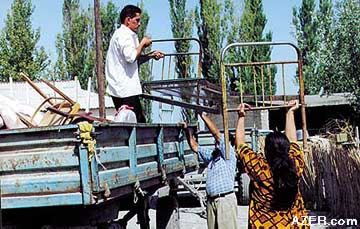  Left: Moving day in October 2000; most families
don't have much to show in terms of material possessions for
the past eight years living as refugees. Left: Moving day in October 2000; most families
don't have much to show in terms of material possessions for
the past eight years living as refugees.
Restored Dignity
It's not like these new shelters are luxurious - or even all
that comfortable - but they represent a measure of hope for refugees
who have been living in appalling conditions ever since they
left their native lands during the Armenian invasion.
"More than anything else," Vugar says, "it seems
to be a question of dignity. Some of these people have literally
been living in pig sties and stables for cattle. Many refugees
have told me that they feel ashamed because they can't build
a house for their family. Whenever a child gets sick, the father
starts blaming himself, saying, 'I couldn't provide a house for
my family; we left our home behind in an area that is now occupied
by enemy soldiers.' The fact that they now own something - a
house - is very important psychologically."
This new sense of pride is something refugees can build on, he
says. "We are speaking about people who are trying to create
a future for themselves. Again, bear in mind that the ultimate
decision for these people will be the day when they are able
to go back home. But until then, we have to think about putting
these people in decent conditions and providing them with a setting
where they can live and send their children to school."
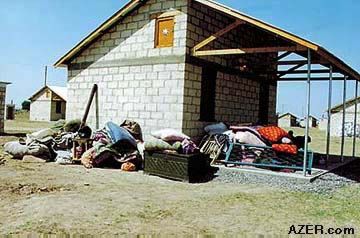  Left: Agip Azerbaijan funded UNHCR as the
umbrella organization to coordinate the $2.25 million project
which will house 400 families and an estimated 2,000 people in
two separate communities - Beylagan and Khanlar. Shelters were
constructed by Relief International Left: Agip Azerbaijan funded UNHCR as the
umbrella organization to coordinate the $2.25 million project
which will house 400 families and an estimated 2,000 people in
two separate communities - Beylagan and Khanlar. Shelters were
constructed by Relief International
Homes Left Behind
The refugees in the new Khanlar settlement come from the Kalbajar
region. Before the Nagorno-Karabakh war, Kalbajar was home to
about 60,000 Azerbaijanis.
"Kalbajar had a very beautiful landscape," says Abdusalimov,
"probably one of the best in Azerbaijan - mountains, forests,
springs. Some of the best spring water in Azerbaijan comes from
Kalbajar; it's called Istisu (Hot Springs)." The region
is also known for the longevity of its people, many of them living
past 100 years.
Maryam Fakhr-Brandt, the UNHCR Community Settlement Consultant
for this project, tells the story of the refugees' March 1993
flight from Kalbajar: "We heard about it from a woman who
had lived in Kalbajar with her brothers. Right before the Kalbajar
area was occupied [April 2], the people in her village were trying
to decide whether they should evacuate. Naturally, they didn't
want to leave, but the Azerbaijani army had already abandoned
its position, and the people were afraid that the Armenian soldiers
would soon occupy their town. No authority told them what to
do. There were only rumors flying around.
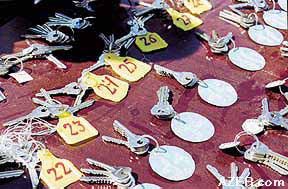  "The villagers
decided to leave. The woman's brothers told her to go on ahead
with some neighbors, and that they would join her later. Since
there were no vehicles to take, she left as quickly as possible
on foot. "The villagers
decided to leave. The woman's brothers told her to go on ahead
with some neighbors, and that they would join her later. Since
there were no vehicles to take, she left as quickly as possible
on foot.
Left: Keys for the brand-new
refugee shelters at Beylagan.
The road south to Aghdam was filled with soldiers, so the villagers
had to flee in the other direction - over a 3,000-meter mountain
- north towards Ganja. There was deep snow on the ground. Some
people died from over-exposure to the cold. This woman made it
to Barda, where her brothers finally caught up with her a week
later."
Meeting the Need
Ever since the Armenian occupation, many of Azerbaijan's 1 million
refugees have been living in miserable conditions: tent camps,
abandoned boxcars, the locker rooms under empty stadiums - even
sheds and buildings originally intended for cattle. Anything
to provide a roof over their heads.
To help improve the refugees' living situation, the Italian oil
and natural gas company Eni, via its subsidiary Agip Azerbaijan,
has funded a $2.25-million settlement project. According to Eros
Agostinelli, Agip's Resident Manager in Baku, the company got
involved simply because so much needed to be done. "Azerbaijan's
most serious problem is its large number of refugees," he
says.
Agip began addressing this issue shortly after it arrived in
Baku in 1995. Agostinelli explains the company's approach: "We
don't want to just spread money on the ground for the refugees;
we want to make an impact by putting that money toward a specific
project that will really make a difference in their lives and
improve their situation."
Most importantly, Agip didn't want to administer the project
themselves - they wanted an experienced NGO to coordinate the
various aspects of the project to ensure that they would be effective.
"Our first choice was UNHCR, the United Nations Organization
for Refugees and IDPs," says Agostinelli, "because
of its experience and operations all over the world. We thought
that establishing a partnership would become useful when similar
problems occur in other countries. Another reason we were looking
for a humanitarian organization was that we didn't want to give
money directly to the government and perhaps be perceived as
trying to gain influence."
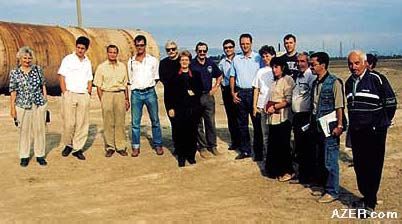
Above:
Diplomatic
delegation visiting the UNHCR / Agip Azerbaijan shelter project
in Khanlar which will house refugees from Kalbajar. The delegation
was led by Didier Laye, UNHCR Representative (4th from left)
and Eros Agostinelli, Manager of Agip Azerbaijan (9th from left)
and included the Italian and British Ambassadors and representatives
from the French and German Embassies and British Parliament.
Water storage tanks are in background. September 2000.
Accountability
UNHCR doesn't carry out all of the work for this massive project-it
contracts with other NGOs in Azerbaijan, using their expertise
in specific areas. UNHCR, under the direction of its Representative
Didier Laye, then reports back to Agip on the progress that has
been made.
Viewed as a "key study" by Eni, the project was begun
in 2000 after Agip and UNHCR came to an agreement on exactly
what it would do. "This wasn't the type of donation where
we give them the money, and then they do what they believe is
best," Agostinelli says. "We had to agree on all aspects
of the project. As far as I know, this type of partnership was
a first for Azerbaijan."
Azerbaijan's government-specifically Ali Hasanov, the Deputy
Prime Minister for Refugees-also had a say in the project, Agostinelli
explains. "We didn't want to do something that the government
didn't agree with. First, the initiative came from us and UNHCR.
Then the government made suggestions and recommendations as far
as where the project should be implemented and which refugee
populations needed the most help. That way we had all of the
parties on board."
Funds are dispersed according to a pre-agreed schedule that has
to be matched by project advancement. Agostinelli describes how
it works: "UNHCR has to give us evidence of what work has
been done and how the funds were spent before we release more
money."
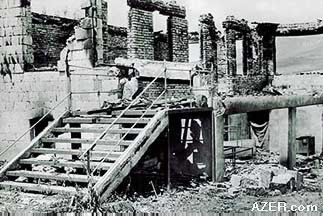  Left: Bombed-out home in the Kalbajar region
of the Caucasus mountains. Azerbaijanis fled this region in Spring
1993. Many of them were able to find shelter only in what used
to be a pig farm where they have been living ever since. Thanks
to Agip Azerbaijan which has just undertaken a $2.25 million
shelter project that the UNHCR is coordinating, some of these
same people have been invited to live as a community together
in new shelters in the Khanlar region. From that location, they
can view the mountain range which used to be their home. Left: Bombed-out home in the Kalbajar region
of the Caucasus mountains. Azerbaijanis fled this region in Spring
1993. Many of them were able to find shelter only in what used
to be a pig farm where they have been living ever since. Thanks
to Agip Azerbaijan which has just undertaken a $2.25 million
shelter project that the UNHCR is coordinating, some of these
same people have been invited to live as a community together
in new shelters in the Khanlar region. From that location, they
can view the mountain range which used to be their home.
New Settlements
Originally, the plan was to build only one settlement site, in
Khanlar. "Then we decided to divide the number of shelters
between two sites, because one site would have been too large,"
says Agostinelli. "It would have made a huge village - much
too difficult to manage."
Agip, UNHCR and the Azerbaijani government decided it would be
better to build two refugee settlements, one in Khanlar and the
other in Beylagan, each with about 200 shelters. If four to five
people are assigned to each shelter, close to 2,000 refugees
will be housed.
Agostinelli believes that these smaller communities will be much
more manageable: "First you start with a limited amount
of people and create a core community. They start to work, and
then eventually others join them. The entire community grows
in phases. Whereas if you did it all in one go with more than
1,000 people, it would hard on everybody. This way there's a
better chance that it can be managed well and that the people's
needs will be met."
The first phase of building shelters has now been completed in
both locations. UNHCR used the services of Relief International
for what is called the "hard sector" - shelters and
other physical facilities. Relief International, based in Santa
Monica, California, has had experience with building similar
refugee shelters.
But the project entails much more than just housing, Agostinelli
points out: "We agreed with UNHCR that the project should
not be focused on only one aspect, building houses. It will have
much more of an impact if it's combined with 'soft sector' assistance,
'soft' meaning health, education, vocational training, income
generation activities and loans. NGOs like International Rescue
Committee (IRC) are more involved in these aspects of the project."
Tough Decisions
With only 200 shelters being built, obviously not all of the
Azerbaijani refugees who need help will benefit from the project.
Deciding who does gets assigned to these shelters is not an easy
task. "Unfortunately, there are a limited number of houses
available," Agostinelli says, "and many people will
be disappointed. That's why it's very important for us to try
to be as fair as possible."
UNHCR has the responsibility of choosing families for the new
shelters, based upon principles set forth by Agip. Top priority
was given to families living in the worst conditions, especially
those led by single mothers. Secondly, no one was forced to move
if they were unwilling. Finally, established communities were
to be kept intact as much as possible. For example, refugees
who lived together in the same cattle farm were to be given houses
close together so that their original community would not be
dispersed.
To find the neediest candidates for the new shelters, a team
from UNHCR, Relief International and IRC conducted a survey.
Maryam recalls: "When we started the survey, we were given
a list of the 300 families who had requested to move. But we
didn't rely on the list. We went and spent time amongst the refugees
and discovered that some of them who were living in the most
pitiful conditions didn't know anything about the project. They
weren't even on our list. So obviously we had to make changes."
NGO representatives found that refugees were living in sub-human
conditions: abandoned pig farms, the locker rooms of an abandoned
stadium, mud brick houses. In particular, they sought out refugees
who had been disabled during the Karabakh war, families who had
a lost a son or the head of the household or families that had
many children. Kalbajar families often have four to five children
each, sometimes spaced only one year apart.
Meeting Resistance
Surprisingly, some of the families who needed the most help were
the most reluctant to move. Maryam remembers: "For some,
it took a great deal of convincing to persuade them that we were
offering them something beneficial. Their solidarity was amazing.
If one Kalbajari said, 'No, I'm not moving,' then often the whole
group said, 'We're not moving either.'"
But they had their reasons. Primarily, they wanted to stay close
to their lifeline of family and friends. After all, more than
anything else, that's how they have had survived throughout this
tragic decade. In one case, five or six refugee families who
were all related to each other didn't want to move. One man told
the NGO representatives, "My wife and I are teachers. I'm
afraid that we won't find work at the new settlement."
A female relative agreed, "If everyone else in the family
moves, I'll move. If they don't, I won't either."
Of course, moving creates uncertainty even under the best circumstances.
The refugees wanted to know what the new conditions would be
like. For instance, refugee camps often have a shop where refugees
can buy food on credit; moving to a different location might
mean not being able to feed the children when cash is scarce.
Or perhaps the refugee family knows a doctor in a nearby town
who is willing to treat their children without being paid right
away. At the new settlement, who could they depend on for help
in the case of a medical emergency?
Also, refugees have come to rely upon the humanitarian aid that
is doled out at the camps. Perhaps they receive free bread or
flour once a month - would they still receive it in the new settlement?
A Better Life
NGO representatives tried to allay their fears by showing them
photos of the shelters and explaining how much land each family
would receive. When shown a panorama of the Khanlar site, refugees
from Kalbajar recognized it as the land where they used to graze
their animals, not more than 20 km away from their original home
on the other side of the mountain.
Just because the land is familiar to the refugees doesn't mean
that they automatically feel secure moving there. Even though
there is a cease-fire in place, refugees wonder what will happen
in the future. Will they be forced to flee again someday?
After asking a lot of questions and seeing photos of the new
shelters, it was often the wives who convinced their husbands
that it was the right decision to move. "I discovered that
the women played a great role in the family," says Maryam.
"The men automatically said, 'No, why should we become a
displaced refugee for the third time? We're going to stay here.'
But the women would ask more questions, such as, 'Would we have
clean water? How much land would we receive? Is there a school
there?' We found that if we could convince the woman, then they
would persuade their husbands."
Some refugees requested changes in the master plans, she says,
which shows a sense of initiative and leadership. "At first
we had to address all of their concerns in the hard sector. We
ended up modifying many things on the site - little things, like
the design of the daycare or the location of the bathhouse. Sure
- a bathhouse is a bathhouse. Naturally, any bathhouse would
be much better than what they had. But if you put the bathhouse
right in the middle of the settlement, some refugees would be
too shy to use it. So we changed its location, making it more
discrete."
Part of the appeal of the new settlement is its dual water system.
Maryam explains: "The refugees will have access to potable
water from a pipeline going from the Lake Goy Gol to Ganja -
it's very good quality water. The authorities in Ganja have authorized
us to extract water from the pipeline, and the refugees will
have about 300 tons. Actually, that's a huge amount. We have
never been able to do this before for any settlement. They will
have a dual system - one will feed the settlement by gravity,
the other one by pump and electrification."
Sustainability
As the shelters are completed, UNHCR will also put "soft
sector" resources into place to help the new communities
support themselves. Assistance with agriculture, education, health
care and small businesses is crucial for building a sense of
community, Agostinelli believes. "The success of this project
must not be judged only on the shelters that have been built
but also on the long-term development of the community. The responsibility
for a donor and for a humanitarian organization is to try to
set the right conditions for a settlement to develop sustainability."
Agostinelli describes the various ways that UNHCR and the NGOs
will help build a thriving community. "We've already made
plans to give the settlements medical facilities, medicine and
equipment. Then, within the community, they'll try to identify
the people who have had training in nursing. They'll give them
more training so that they can run the clinic. For the schools,
they'll find the teachers in the community and give them training
to teach." The project will also provide furniture for the
schools, books, educational materials and vocational training.
"For the micro-credit loans," he says, "they'll
identify people in the community who are willing to start their
own small businesses. They'll give them training in the type
of business they want to undertake, and then give them a small
loan to purchase the equipment that they need, to get them started."
Fighting Donor
Fatigue
After eight years of supporting thousands of refugees, international
donor support has been declining in Azerbaijan. Maryam theorizes:
"I think most people from the outside get tired of hearing
about the refugees - especially ones who have been made homeless
in their own countries. And I think these people themselves get
tired of asking for help. You can read it in their eyes. If you
only give them the opportunity, they can be better than many
of us. They have great potential - they've just lost their dignity."
Like several humanitarian projects in Azerbaijan, the Agip settlement
project is designed to help Azerbaijanis eventually become self-sufficient.
Vugar explains why this philosophy is so important: "You
can't go on forever giving people food and blankets. You don't
want to make these people dependent on you, so that they're just
sitting around idle. At the end of the day, you don't want to
have a guy with an outstretched hand.
"We believe that there will be a day when these people will
be able to leave these shelters and go back to their land of
origin. But until that day comes, these people have the right
to live in decent conditions."
For Agostinelli, figuring out what goes into making a sustainable
village is a new experience. "I've never dealt with the
humanitarian sector before. It's a fascinating process. You really
have to put a good deal of effort into it to guarantee that it
will really turn out right. But it's an important sector for
us because, as an oil company, we often work in developing countries
that have great social problems. Establishing good community
relations by undertaking worthy projects is important to our
business."
Other UNHCR representatives who contributed to this article include
Ulvi Ismayil, Senior Field Clerk; Naila Velikhanova,
Senior Field Clerk; and Nijat Karimov, UNHCR Field Offshore,
Barda Office Manager.
____
From Azerbaijan
International
(8.4) Winter 2000.
© Azerbaijan International 2000. All rights reserved.
Back to Index
AI 8.4 (Winter 2000)
AI Home
| Magazine Choice | Topics
| Store
| Contact
us
|